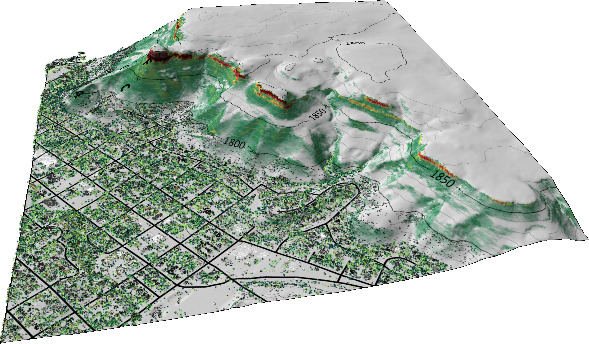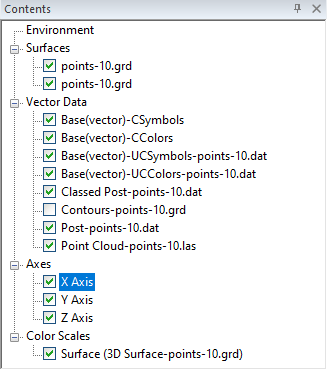3D View Window
Click the Map Tools | View | 3D View
command ( ) or the 3D View button in
the Map frame View
properties page to open a 3D view window of the selected map. A new 3D
view is created for the selected map. A 3D view can also be created by
right-clicking a map or map layer and clicking 3D
View in the context menu. To create a 3D view, the map must include at least one of the following: a grid-based layer, a base from data, a post or classed post layer, a point cloud layer, a drillhole layer, or a base (vector) layer with a 3D object. The document tab includes
the file name and view number. For example, when a 3D view is created
for a map in the Plot1 plot window, the plot window tab name is Plot1:1 and the 3D view window
tab name is Plot1:2.
) or the 3D View button in
the Map frame View
properties page to open a 3D view window of the selected map. A new 3D
view is created for the selected map. A 3D view can also be created by
right-clicking a map or map layer and clicking 3D
View in the context menu. To create a 3D view, the map must include at least one of the following: a grid-based layer, a base from data, a post or classed post layer, a point cloud layer, a drillhole layer, or a base (vector) layer with a 3D object. The document tab includes
the file name and view number. For example, when a 3D view is created
for a map in the Plot1 plot window, the plot window tab name is Plot1:1 and the 3D view window
tab name is Plot1:2.
The 3D view window displays a map in a three-dimensional view space.
-
Grid-based layers from the plot window are rendered as surfaces (XYZ grids) or volumes (XYZC grids) in the 3D view. The visualizations from the grid-based maps are also overlaid on the surface. For example, contour lines or color relief layers will be overlaid on the surfaces. Contour may also be rendered as 3D polyline objects.
-
Base (vector and raster), post, and classed post layers are overlaid on the surfaces as textures. Point data in base from data, post, and class post layers are also displayed in 3D. Base (vector) layers with 3D polylines, 3D polygons or a 3D polymesh in them will display those objects in true 3D as well.
-
Drillhole layers are rendered as drillhole paths.
-
Point cloud layers are rendered as a 3D point cloud.
-
The 3D view window only displays layers that are visible in the map in the plot window. Show or hide surfaces, textures, and vector data in the 3D view by selecting or clearing the visibility check boxes in the 3D view Contents window. Completely remove a surface, texture, or vector data from the 3D view by switching to the plot window and turning the visibility off for the associated map layer.
|
|
|
The 3D view displays the map in a three-dimensional space. This map includes contour, color relief, post, base, and point cloud layers. |
3D View Commands
The 3D View ribbon tab contains commands for modifying the view and creating videos and images in the 3D view window.
|
Zoom to fit the entire map in the 3D view window |
|
|
Zoom in on the center of the 3D view window |
|
|
Zoom out from the center of the 3D view window |
|
|
Realtime |
Zoom by clicking and dragging the mouse |
|
Pan the 3D view window |
|
|
Rotate the 3D view window |
|
|
Walk along the surface in the 3D view window |
|
|
Move the 3D view to the home position |
|
|
Set the 3D view home position |
|
|
Create or edit a fly-through |
|
|
Play the fly-through |
|
|
Create a video with the current fly-through settings |
|
|
Save XYZ coordinates to a text file |
|
|
Copy an image of the 3D view window to the clipboard |
|
|
Export the current view in the 3D view window as an image |
|
|
Export the map in the 3D view window to a 3D PDF model |
Contents
The Contents window contains the Environment and the surface and vector objects in the 3D view. Surfaces are generated from the grids in the map, and Vectors are generated from the point cloud and contour layers in the map. Select the objects in the Contents window to change the properties of the 3D view and the map in the 3D view. A check mark next to the layer name indicates the layer is displayed in the 3D view. Clear the check box next to a layer to hide the layer in the 3D view.
|
|
|
The Contents window includes the surfaces, vectors, axes, and color scales in the 3D View. |
Environment
The Environment object in the Contents window contains the properties for the 3D view. Select the Environment to modify the 3D view background, vertical exaggeration, water level, camera, and lighting. The Environment object has three Properties pages:
The Lighting properties have no effect on the 3D view when a hill shaded or reflectance shaded color relief layer is present in the map. Turn off hill shading and reflectance shading for the color relief layer(s) to use the EnvironmentLighting properties.
3D Grid Volumes Group
The 3D Grid Volumes group in the Contents window contains the 3D grids in the 3D view. A volume render and map layer slice are created for each 3D grid.
Isosurfaces and image slices can be added to the 3D view for 3D grids. All 3D grid visualizations can include a clipping plane.
2D Grid Surfaces Group
The Surfaces group in the Contents window contains the surfaces in the 3D view. A surface is created for each grid in the map. The Surface group includes properties for controlling the rendering quality of all the surfaces in the 3D view and their overlay textures. The Surfaces group has one Properties page, General.
Individual Surfaces
Each surface in the 3D view can have overlays from the map. The available overlay textures are listed under the General page in the Properties window for each surface. Available textures include the grid-based map visualizations, e.g. contours and color relief, as well as any base or post layers in the map. Individual overlays can be hidden or displayed on each surface by selecting the surface you wish to edit in the Contents window, and then selecting or clearing the visibility check boxes next to the overlay layer names in the Textures to display section of the General page.
By default, each surface shows the texture from any map layer that uses the same grid file as the surface, and the textures from any base or post layers. Use the General page to hide or display textures.
The overlay textures do not have any 3D view properties. To change the appearance of the overlays, modify their properties in the plot window. Switch to the plot window by clicking the plot window document tab.
Vector Data Group
The Vector Data group in the Contents window contains the 3D vector objects in the 3D view, i.e. point cloud layers and 3D polyline contours. There are no Vector Data group properties.
Contours
Contours are created for contour layers in the map. By default, the contour layer is displayed as a texture overlay on the surface. Vector contour lines are hidden by default. Select the check box next to the contours vector object in the Contents window to display the contours. Change the properties of the contours on the General page of the Properties window. Leave the contours the same as those assigned in the 2D plot by selecting Same as plot for Color Method. Or, select Fixed to change the contours to have the same color and width in the 3D view.
Vector Data
3D point vector data is displayed for post and classed post layers in the map. 3D point, polygon, and polyline vector data is displayed for base (vector) layers in the map. The post, classed and post layers have one Properties page, General; and the base(vector) layer has two Properties pages, General and Z coordinate.
Point Clouds
Select the individual point cloud layers within the Vector Data group to change the Point size for the point clouds. The point cloud layers have one Properties page, General. The number of points in the point cloud is limited by the 3D View maximum number of points in the Options dialog Rendering page.
Drillhole Group
3D drillhole layers are created for drillhole layers in the map. The Drillhole group has no properties. See the 3D Drillhole Properties topic for Points, Intervals, Path, and Label properties for 3D drillhole layers.
Axes Group
Three axes are automatically created for a map in the 3D view in Surfer. The Axes group in the Contents window contains the X, Y, and Z axes for the 3D map. All the axes are displayed by default. Clear an axis to remove it from the 3D map. Each axis has four Properties pages. Click on the axis in the Contents window to change its properties in the Properties window:
Color Scales Group
The Color Scales group in the Contents window contains color scales in the 3D view. A color scale is created for 2D layers that have a colormap. The Color Scales group adds or hides a color scale on the plot. The color scales can include any number of post, classed post, 1-grid vector, 2-rid vector, contour, point cloud and base colormaps from any of the maps in the plot. The total number of color scales is limited to the total number of layers that have their own color scales. The Color Scales group has one Properties page, Color Scales.
Individual Color Scales
Each color scale in the 3D view can have overlays from the map. The available overlay color scale for each 2D layer are listed under the Color Scales page in the Properties window. Select the color scale you wish to display on the 3D view. Clear the color scale to remove it from the 3D view. Color scales that are displayed may be edited by selecting the color scale in the Contents window. Color scales have four Properties pages:
Color scales will not export to a 3D file but will export to images and be copied to the clipboard.

